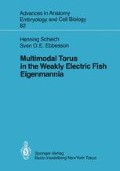Abstract
Ever since the behavioral work of Lissmann (1958), who showed that the weak electric discharges of some families of fish (hitherto considered useless for prey capture or for scaring away enemies) are part of a strange sensory system, these fish have attracted attention from biologists. The subsequent discovery of the electroreceptors in the skin of gymnotids and mormyrids (Bullock et al. 1961; Fessard and Szabo 1961) and the evidence that the ampullae of Lorenzini of nonelectric sharks and rays are also electroreceptors (Digkgraaf and Kalmijn 1962) was a start for a lively branch of physiological, anatomical, and behavioral research. Many findings of general importance for these fields have made the case to which extremes the performance of the central and peripheral nervous systems can be driven. Among those findings is the temporal accuracy of the pacemaker of some high-frequency fish which controls the electric organ, probably the most accurate biological clock (coefficient of variation <0.01%, Bullock 1982). The functional analysis of the pacemaker cells and their axons has established most of our knowledge on electrotonic synapses, the alternative to chemical synapses (Bennett et al. 1967), and of the implications of axonal delay lines for achieving extreme synchrony of parallel inputs to postsynaptic elements (Bennett 1972; Bruns 1971). Extreme control of temporal activity is also reflected in the molecular layer of the gigantocerebellum of mormyrids (Nuiwenhuys and Nicholson 1969), probably the most accurate piece of latticework of neural elements in all central nervous systems.
Access this chapter
Tax calculation will be finalised at checkout
Purchases are for personal use only
Preview
Unable to display preview. Download preview PDF.
Author information
Authors and Affiliations
Rights and permissions
Copyright information
© 1983 Springer-Verlag Berlin Heidelberg
About this chapter
Cite this chapter
Scheich, H., Ebbesson, S.O.E. (1983). General Introduction. In: Multimodal Torus in the Weakly Electric Fish Eigenmannia. Advances in Anatomy Embryology and Cell Biology, vol 82. Springer, Berlin, Heidelberg. https://doi.org/10.1007/978-3-642-69166-9_1
Download citation
DOI: https://doi.org/10.1007/978-3-642-69166-9_1
Publisher Name: Springer, Berlin, Heidelberg
Print ISBN: 978-3-540-12517-4
Online ISBN: 978-3-642-69166-9
eBook Packages: Springer Book Archive

